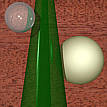
PET exists both as an amorphous (transparent) and as a semi-crystalline (opaque and white) thermoplastic material. Generally, it has good resistance to mineral oils, solvents and acids but not to bases.
The semi-crystalline PET has good strength, ductility, stiffness and hardness. The amorphous PET has better ductility but less stiffness and hardness.
Danish Name
Category
Products
Trays for oven use
Oven foils
Audio and video tapes
Thermo scarf (fleece)
Processes
Plastic injection moulding
Extrusion
Blow moulding
Vacuum forming
Fibre spinning
Similar materials
PBT (technical applications)
PVC (packaging material)
PE (packaging material)
PS (packaging material)
Price
Environmen- tal notes
Use: It is very inflammable and inflammability can be reduced by the use of additives.
Disposal: Incineration in an incineration plant mainly produces water and carbon dioxide. Heating value is equivalent to 1/2 kg of oil. PET can be recycled into fibres that are used for polyester fabrics.
Photo
Copyright
This page is part of Design inSite
Disclaimer